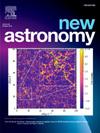从核心坍缩超新星遗迹中学习爆炸机理
IF 2.1
4区 物理与天体物理
Q2 ASTRONOMY & ASTROPHYSICS
引用次数: 0
摘要
我估计了抖动射流爆炸机制(JJEM)的一些典型性质,以区别于与之竞争的超新星爆炸模型。从一些CCSN残余物外围的抖动射流的印迹来看,我估计形成CCSN残余物的抖动射流的半开口角是αj≃1°−10°。我还估计,新诞生的中子星(NS)周围的间歇性吸积盘在它们围绕NS的轨道周期只有几倍之后就可以发射射流。为了运行,JJEM需要间歇式吸积盘来发射射流,以放大发电机中的磁场,并使磁场重新连接并迅速释放能量。我估计磁场重联带的宽度在地球磁场表面附近为Drec≈0.005r≈0.1km。这个宽度要求的数值分辨率比目前CCSN模拟的分辨率小几倍。因此,我认为现有的CCSN爆炸机制模拟还远远不能正确地模拟CCSN爆炸。本文章由计算机程序翻译,如有差异,请以英文原文为准。
Learning from core-collapse supernova remnants on the explosion mechanism
I estimate some typical properties of the jittering jets explosion mechanism (JJEM) to distinguish it from competing supernova explosion models. From the imprints of jittering jets in the outskirts of some CCSN remnants, I estimate the half-opening angles of jittering jets that shape CCSN remnants to be . I also estimate that intermittent accretion disks around the newly born neutron star (NS) can launch jets after they live for only several times their orbital period around the NS. To operate, the JJEM requires intermittent accretion disks that launch jets to amplify the magnetic fields in a dynamo, and the magnetic fields to reconnect and release their energy rapidly. I estimate the width of magnetic field reconnection zones to be near the surface of the NS. This width requires a numerical resolution several times smaller than the resolution of present CCSN simulations. I argue, therefore, that existing simulations of the CCSN explosion mechanism are still far from correctly simulating CCSN explosions.
求助全文
通过发布文献求助,成功后即可免费获取论文全文。
去求助
来源期刊

New Astronomy
地学天文-天文与天体物理
CiteScore
4.00
自引率
10.00%
发文量
109
审稿时长
13.6 weeks
期刊介绍:
New Astronomy publishes articles in all fields of astronomy and astrophysics, with a particular focus on computational astronomy: mathematical and astronomy techniques and methodology, simulations, modelling and numerical results and computational techniques in instrumentation.
New Astronomy includes full length research articles and review articles. The journal covers solar, stellar, galactic and extragalactic astronomy and astrophysics. It reports on original research in all wavelength bands, ranging from radio to gamma-ray.
 求助内容:
求助内容: 应助结果提醒方式:
应助结果提醒方式:


